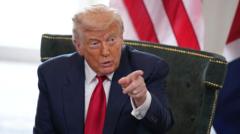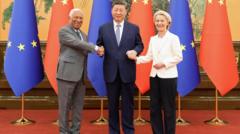The new trade agreement between the US and EU is being heralded as a historic milestone, but the implications reveal a complex landscape of winners and losers across different industries. While the agreement boosts some sectors, it presents challenges for others, raising questions on the economic balance between the two trading partners.
Analyzing the US-EU Trade Deal: Winners, Losers, and Implications

Analyzing the US-EU Trade Deal: Winners, Losers, and Implications
The recent US-EU trade deal presents both opportunities and challenges for various sectors, impacting economies on both sides of the Atlantic.
The US and the European Union have recently finalized what is being described as a historic trade agreement, with negotiations held in Scotland. However, it is essential to note that this arrangement appears more as a framework than a comprehensive trade deal, as many specifics remain unresolved. Yet, the key figures shared by President Donald Trump and EU Commission head Ursula von der Leyen indicate which groups might bear the brunt or benefit most from the deal.
**Trump emerges as a winner.** After vowing to secure new trade agreements with multiple countries, Trump’s negotiations with the EU have culminated in the largest trade deal to date. Analysts suggest that the EU concessions may hurt its economy by approximately 0.5% in GDP terms. Moreover, the US is set to gain billions of dollars through raised import tariffs. However, the euphoric headlines may fade quickly if upcoming economic reports show negative repercussions tied to Trump's aggressive economic strategies.
**US consumers, however, could be facing increased costs.** The deal may exacerbate financial strains due to heightened prices on European goods. Even though a 15% tariff is a reduction from previous rates, it remains a considerable hurdle, further inflating prices for American buyers. Tariffs are essentially taxes imposed on foreign goods; thus, a product priced at $100 will incur an additional $15 for US consumers, putting the financial burden on end-users.
In stark contrast, the **stock markets showed a positive reaction.** On the day the framework was announced, markets across Asia and Europe registered increases. The 15% tariff on EU goods, although significant, is viewed by investors as providing robust market stability. Brokers like Chris Weston have characterized the agreement as market-friendly, potentially strengthening the euro.
**European member states might face internal divisions.** The agreement needs approval from all 27 EU nations, who have varying levels of dependency on US market access. Feedback has been mixed, with some nations expressing skepticism and concern over the consequences of this agreement in light of ongoing geopolitical issues, including the war in Ukraine.
**The German automotive sector could also see challenges.** Car manufacturers are relieved by the reduction of import tariffs from 27.5% to 15%, but this still poses substantial financial jeopardy to the German automotive industry, a critical component of the EU economy. Meanwhile, American car manufacturers could benefit from the EU cutting tariffs on US-made vehicles, potentially increasing sales in Europe.
In another realm, **the pharmaceutical industry in Europe faces uncertainty.** There is confusion surrounding the tariffs on EU-produced medications entering the US market. While European leaders urged minimal tariffs to protect their industry, Trump has suggested that some pharmaceuticals may not benefit under the current agreement. This discord has raised concerns about the impact on the European pharmaceutical sector, particularly regarding high-demand drugs marketed in the US.
**On a positive note for US energy,** Trump announced a substantial commitment from the EU to purchase $750 billion in US energy resources. This strategic decision is timely, given Europe’s decreasing reliance on Russian natural gas amidst the ongoing conflict in Ukraine.
Lastly, **the aviation sector for both the US and EU could operate without tariffs on essential components.** Certain critical products, including aircraft machinery and some agricultural commodities, will not face tariffs, easing the interchange of these goods between both regions.
As this historic agreement unfolds, it promises to reshape transatlantic trade relations significantly, bringing with it a wave of challenges and opportunities that will impact various sectors on both sides of the Atlantic.




















